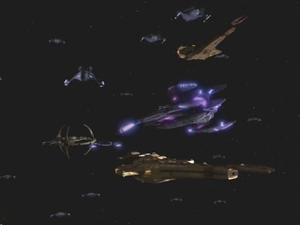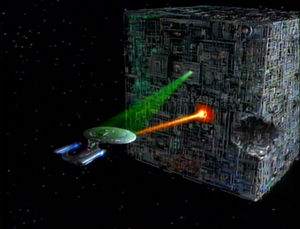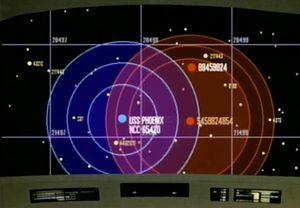ST weapon accuracy and range
This article deals with demonstrated accuracy and range of various weapons used by major Star Trek civilizations like the Federation, Borg, Dominion, and Klingon Empire.
As the examples provided below demonstrate, engagement range for Star Trek vessels is extremely inconsistent. In combats shown on screen, engagements occur at ranges of a few hundred meters up to several kilometers. Dialogue, on the other hand, often describes ranges of tens of thousands of kilometers. Furthermore, ranges in 23rd century engagements (TOS) are often greater than ranges in 24th century engagements (TNG).
There is no clear explanation for the discrepancies, but there is plenty of speculation:
- Electronic countermeasures may prevent accurate targeting from extended range, forcing ships to close to ensure hits. This would be particularly likely in large fleet engagements.
- Star Trek ships often target specific systems on enemy vessels, especially in the 24th century. Such precision targeting might require closing the distance, especially where ECM is in use.
Examples
TOS "The Changeling"
The Enterprise, under attack from the one-meter-tall probe Nomad, returns fire with photon torpedoes. While the precise range is uncertain (the ship was using evasive maneuvers), the last stated range was 90,000 kilometers. A direct hit was reported, although it had no effect. Of course, the same episode says that Nomad hit the Enterprise with the equivalent of 90 photon torpedoes in one shot, and all it did was reduce their shields by 20%; so according to this episode, it would take 450 photon torpedoes to inflict serious damage on a Constitution-class starship.
TOS "Journey to Babel"
Under attack by an Orion vessel, the Enterprise plays dead. The attacker halts it's warp strafing attack, dropping to sublight and closing on the Enterprise. At a stated range of 75,000 kilometers, Kirk orders the helmsman to fire phasers, scoring a direct hit.
TOS "The Deadly Years"
Having taken command of the Enterprise, Commodore Stocker attempts to reach a starbase by taking the ship on a shortcut through the Romulan Neutral Zone to get urgent medical care to the rapidly aging Kirk, Spock, McCoy, and Scott. The ship is consequently attacked by several Romulan Birds of Prey. When Kirk resumes command, Sulu informs him that the range of the Romulan vessels is "fifty to one-hundred thousand kilometers".
TNG "Q Who"
When the Enterprise is attacked by a Borg Cube, Picard orders Worf to target the source of the tractor beam and fire. Shockingly, it takes Worf four tries to hit the beam emitter from point-blank range; the first three shots aren't even close! The range appears to be a kilometer or less.

TNG "Conundrum"
Riker says they are still 55 seconds from "optimal firing range" of the Lysian Central Command, even though they appear to be practically on top of a stationary target that is both very large and very poorly defended (by Federation standards). Although the crew up to that point had been deceived by a Satarran agent into thinking of the Lysians as dangerous opponents, their sensors clearly showed the inferior quality of the Lysian defenses.
At any rate, "optimal firing range" is not necessarily the full range capability of the ship.
TNG "Yesterday's Enterprise"
Three un-cloaked Klingon Birds of Prey close to within a few kilometers before firing on the Enterprise. Likewise, the Enterprise, knowing they will be attacked by the Klingons, doesn't fire until the enemy is at close range (there is no political reason to delay firing, since the Federation is in a state of war with the Klingons in this alternate-timeline episode). The dialogue describes ranges of hundreds of kilometers, but as usual, the visual effects are not consistent with the words.
TNG "The Wounded"
This episode is often cited as evidence for long-range combat by major ST civilizations:
- DATA: The warship is three hundred thousand kilometers from the Phoenix. It is opening fire. The Phoenix has taken a direct hit ... the Phoenix is beginning evasive maneuvers ... it has positioned itself outside the weapons range of the opposing ship ... the Phoenix has powered up with both phasers and photon torpedoes ... the Phoenix is firing photon torpedoes.
As Data is speaking, the viewscreen shows a two-dimensional display of the battle. If this display is oriented to provide the most useful view of the battle (placing all three of the vessels being tracked in the same plane), then it shows the relative weapon ranges of the ships and the distance between the them. The display casts doubt on Data's description of the battle, since the viewscreen shows that the Phoenix is still well within weapons range of the Cardassian ship, which actually has greater range than the Phoenix if the display is accurate.
It should also be noted that the ships involved in the battle are travelling at warp speeds, so a gap of 300,000 km could easily drop to zero in less than a second. It may also be worth noting that the Phoenix engaged with torpedoes, and the Cardassian ship was pursuing the Phoenix: the Phoenix would therefore have been running away from any torpedoes fired by the Cardassian ship, while the Cardassian ship was running toward the torpedoes fired by the Phoenix, possibly explaining the "out of range" statement (assuming torpedoes have greater range than phasers).
The battle between the Enterprise and the Cardassian warship, Trager, earlier in the episode, further disproves any optimistic interpretation of Data's range description. As the screenshot to the left shows, the ships engage at a range of several hundred meters. Presumably, the Cardassians closed to optimum range to maximize the effect of catching the Federation starship off-guard. Even so, the Trager's ambush caused only minor damage.
TNG "The Arsenal of Freedom"
Left in command of the Enterprise, Geordi takes the drive section of the ship into the atmosphere of the planet Minos to lure a cloaked alien drone into following them. The drone pursues them into the atmosphere, where they are able to detect its wake and target it. If the drone were capable of attacking from a range of thousands of kilometers, it would not have needed to follow the Enterprise into the planet's atmosphere. Geordi's tactic is presumably based on the assumption that the Minosian drone's targeting limitations are similar to their own.
Earlier in the episode, a shot from the drone hits the Enterprise, and the source appears to be in shot but not visible. It's not clear whether the drone is too far away to be visible or simply not visible to the naked eye because of its alien cloaking technology; while it shows up briefly on sensors when attacking (too briefly to be successfully targeted by Federation weapons), the drone is never actually seen until it enters the planet's atmosphere.
TNG "A Matter of Honor"
A Klingon Bird of Prey is preparing to attack the Enterprise-D. Riker, serving aboard as an exchange officer, advises to the Klingon captain to close to within 40,000 km before firing.
- RIKER: You'll get only one shot.
- KARGAN: We'll only need one. Stand by on phasers and torpedoes. Prepare to fire them simultaneously.
- RIKER: I recommend you don't fire until you're within forty thousand kilometers.
- KLAG: Why?
- RIKER: It will cut down their response time.
The dialogue suggests that the ships could have engaged from a range of more than 40,000 km.
DS9 "The Search, Pt. I"
The Defiant is travelling at warp and under cloak within Dominion space. Long-range sensors detect two Jem'Hadar warships cruising at warp five on a course that will bring them within 100,000 kilometers. Kira says that's well within their weapon range.
DS9 "The Die is Cast"
Commander Sisko orders Dax to bring the Defiant to within 500 meters of a group of Jem'Hadar fighters before firing on them. The advantage he sought by closing to such short range isn't clear. The Jem'Hadar attack ships opened fire from a reported 50 kilometers range, a brief glimpse of the Defiant's viewscreen supports this.

DS9 "Call to Arms"
In this episode, a Dominion fleet attacks Deep Space 9. Even when engaging a completely immobile target, the Dominion ships close to within several kilometers before opening fire.
The screenshot on the right shows the Dominion/Cardassian fleet approaching Deep Space 9 to the point of it taking up a significant fraction of the field of view. Yet in the following scene, Damar reports that they will not be in weapons range for another minute[1].
After the battle is joined, the attacking fleet continues to fight at extremely close ranges; however, even ranges of several hundred meters appear to be too great for Deep Space 9 targeting sensors to achieve a reasonable accuracy. On the left we can see a Cardassian Hideki-class attack ship flying straight towards Deep Space 9's central assembly. The Hideki doesn't change course or attempt to evade incoming fire, yet Deep Space 9 only scores two grazing shots on it, thus failing to stop the craft.
Further evidence of limited accuracy comes from the end of the episode. As the Defiant and a Bird of Prey flee DS9, the Dominion fleet opens fire, and we see 11 shots fired without a single one hitting the fleeing ships. The shots can be seen at right, and -- as is immediately apparent -- the ships are flying in a tight formation without making any attempts to evade enemy fire. As before, the range is on the order of several hundred meters or several kilometers at most.
VOY "Basics, Part I"
Voyager comes under attack from several Kazon Predator-class ships, with ranges stated in thousands of kilometers. The Kazon begin firing torpedoes from more than 10,000 kilometers. Janeway refuses to return fire until closer than 2000 kilometers.
Relevant dialog:
- PARIS: Here we go.
- TUVOK: They are randomly detonating torpedoes in our flight path.
- KIM: Shields are holding. No damage.
- JANEWAY: Hold your fire, Mister Tuvok. They may have torpedoes to waste. We don't.
- PARIS: Thirty seconds to intercept.
- JANEWAY: Take us out of warp.
- PARIS: Engaging impulse engines.
- JANEWAY: Power to all weapon systems. Stand by phasers.
- TUVOK: Kazon vessel ten thousand kilometres off our starboard bow.
- JANEWAY: Not yet.
- TUVOK: Six thousand kilometres.
- JANEWAY: Not yet.
- TUVOK: Five thousand, three, two thousand.
- JANEWAY: Now.
- PARIS: Initiating evasive manoeuvres, beta sequence.
- TUVOK: Two more Kazon ships approaching.
- KIM: Shields at ninety percent.
- JANEWAY: Janeway to Torres. Initiate holo-programs.
It is clear that Voyager could at the very least have fired photon torpedoes at any time, but Janeway clearly wants to conserve them. It is also apparent that the Kazon could not accurately target the Voyager at warp speed, as they were "randomly" detonating torpedoes ahead of the ship. Indeed, even at sublight speeds, Paris saw no reason to begin evasive maneuvers until closer than 2000km.
As usual for Star Trek, the visual effects shots are inconsistent with the dialogue, showing engagement ranges of a few thousand meters, at most.
VOY "Non Sequitur"
Ensign Harry Kim is thrust into an alternate timeline where he never served on Voyager. In order to get back to his proper timeline, he convinces the alternate timeline Paris to help him steal a runabout and return to the temporal phenomena that brought him from his timeline to this one. Consequently they are pursued and fired on from several thousand kilometers by a Nebula-class starship.
The relevant dialog:
- KIM: We've got a starship on our tail. Nebula-class.
- PARIS: I'll try to lose 'em Harry, but they're a lot faster than we are.
- Voice: Attention runabout Yellowstone. Power down your engines or we will open fire.
- KIM: They're going to try to do everything they can to stop us. They think we're trying to steal this prototype.
- PARIS: They're closing to five thousand kilometres.
- KIM: Shields down to 70 percent. 50 percent. 29 percent.
Remarkably, in a cut scene between when Paris calls out the range and when Kim calls out shield damage, the visuals show the Yellowstone being hit by the Nebula's phaser beam which appears from far behind it, then the runabout passes out of view and the Nebula immediately appears as a small point, grows larger as it nears the camera, and then passes offscreen as the runabout did.
VOY "Equinox"
Voyager reportedly attacks the Equinox with phasers from 30,000 km away. Upon closer inspection of the episode, however, we find that no evidence of such range exists. On the contrary, the episode implies far shorter maximum ranges of Federation ships.
The relevant dialog:
- [Bridge]
- PARIS: Thirty thousand kilometres and closing.
- JANEWAY: Target their power core.
- [Equinox Bridge]
- GILMORE: Direct hit. Minor damage.
- RANSOM: Return fire.[2]
Since Janeway only instructed the crew to start targeting Equinox's power core at 30,000km, and since there is a scene cut between the order and the first known hit, there is no way to determine how far away Voyager actually was when it started firing upon Equinox.
Further events in the episode suggest much lower ranges:
- RANSOM: Lay in a course through the planet's atmosphere. Sixty degree vector.
- [Bridge]
- JANEWAY: What the hell is he doing. Follow him!
- PARIS: Crossing the upper thermosphere.
- JANEWAY: Phasers.
- TUVOK: Shields are weakening. Thirty one percent, twenty nine.
- KIM: Inertial dampers are offline.
- CHAKOTAY: Captain, if we loose our shields we'll be attacked by the aliens. Captain!
- JANEWAY: Break off pursuit.
If Voyager were capable of scoring hits from anywhere near 30,000km, there would be no need to follow the Equinox into the atmosphere and risk damage due to atmospheric friction.






